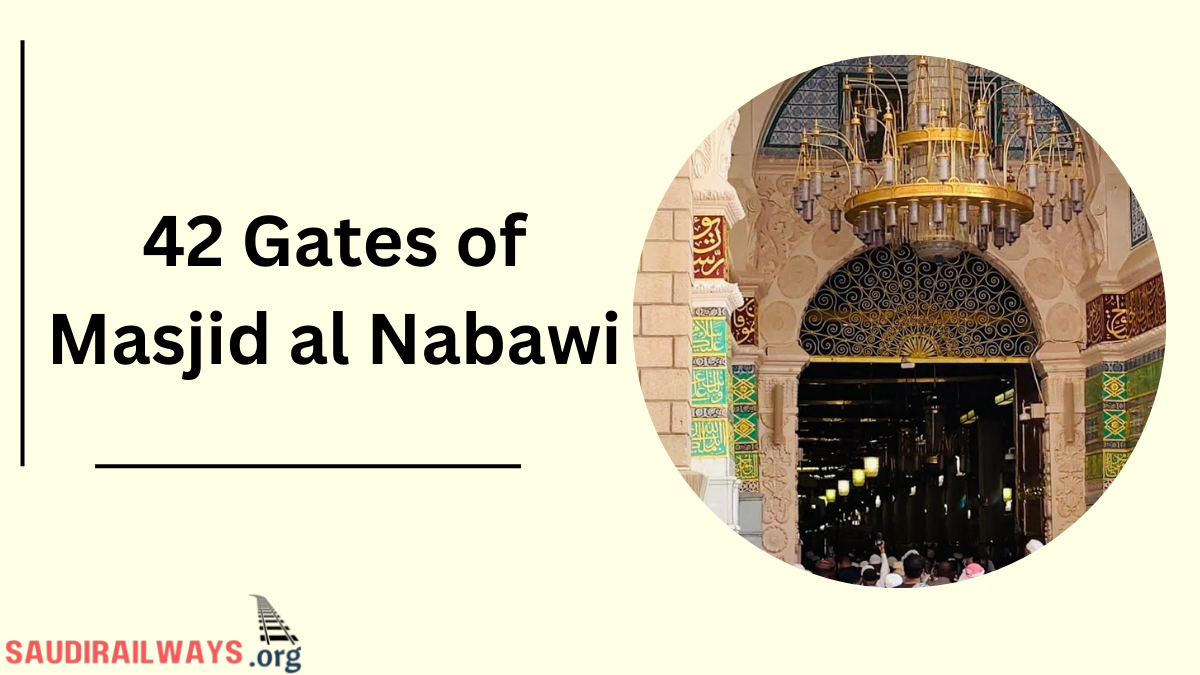Masjid al Nabawi, also known as the Prophet’s Mosque, is one of the most important and sacred places in Islam. Located in Medina, Saudi Arabia, it is the second holiest site in Islam, after the Masjid al-Haram in Mecca.
The mosque is renowned not only for its spiritual significance but also for its beautiful architecture, including its 42 gates that provide access to worshippers from all directions.
Contents
A Brief History of Masjid al Nabawi
The Prophet Muhammad (peace be upon him) built Masjid al Nabawi in 622 CE, shortly after his migration from Mecca to Medina. Over the centuries, the mosque has undergone numerous expansions and renovations, making it one of the largest and most visited mosques in the world.
The Importance of Gates
The gates of Masjid al Nabawi are not only functional, allowing easy access for millions of pilgrims, but they also hold historical and spiritual significance. Each gate has a name, often commemorating notable companions of the Prophet or significant events in Islamic history.
List of the 42 Gates of Masjid al Nabawi
Here is a comprehensive list of the 42 gates, with a brief description of their significance:
Bab al-Salam (Gate of Peace)
- One of the main entrances, known for its beautiful decorations.
Bab al-Baqi’
- Leads to the famous Al-Baqi’ cemetery, where many companions of the Prophet are buried.
Bab al-Majeedi
- Named after Sultan Abdul Majeed, who ordered a major renovation of the mosque.
Bab al-Siddiq
- Named in honor of Abu Bakr al-Siddiq, the first Caliph of Islam.
Bab al-Rahmah (Gate of Mercy)
- Symbolizes the mercy of Allah.
Bab Jibril (Gate of Gabriel)
- Named after the angel Gabriel, who brought revelations to the Prophet.
Bab al-Nisa’ (Gate of Women)
- Specifically designated for women to enter the mosque.
Bab al-Hijrah
- Commemorates the migration of the Prophet from Mecca to Medina.
Bab al-Aqeeq
- Named after the nearby Aqeeq Valley.
Bab Ali
- Named in honor of Ali ibn Abi Talib, the fourth Caliph.
Bab al-Malik Abdul Aziz
- Named after King Abdul Aziz, founder of modern Saudi Arabia.
Bab al-Malik Fahd
- Named after King Fahd, who initiated significant expansions.
Bab al-Malik Abdullah
- Named after King Abdullah for his contributions to the mosque’s expansion.
Bab al-Badr
- Commemorates the Battle of Badr, a significant event in Islamic history.
Bab al-Imam Ali
- Another gate named after Ali ibn Abi Talib, acknowledging his importance.
Bab al-Khattab
- Named after Umar ibn al-Khattab, the second Caliph.
Bab al-Uthman
- Named after Uthman ibn Affan, the third Caliph.
Bab al-Safa
- Symbolizes purity and peace.
Bab al-Tawheed
- Represents the oneness of Allah.
Bab al-Siddiqeen
- Named after the truthful ones, referring to the Prophet’s close companions.
Bab al-Mujahideen
- Honors those who strive in the way of Allah.
Bab al-Qiblah
- Indicates the direction of prayer towards the Kaaba in Mecca.
Bab al-Fath
- Symbolizes victory and triumph.
Bab al-Iman
- Represents faith.
Bab al-Hijrah
- Another gate commemorating the Prophet’s migration.
Bab al-Haram
- Denotes sanctity and protection.
Bab al-Hijaz
- Named after the region of Hijaz in Saudi Arabia.
Bab al-Quraysh
- Named after the Prophet’s tribe, Quraysh.
Bab al-Siddiqeen
- Another gate honoring the truthful companions.
Bab al-Aliya
- Represents elevation and high status.
Bab al-Rahman
- Another gate symbolizing mercy.
Bab al-Harith
- Named after Harith ibn Abdul Muttalib, the Prophet’s uncle.
Bab al-Aziz
- Symbolizes might and power.
Related Articles
- 8 Miqat Locations for Wearing Ihram for Umrah
- How to Find Building Numbers with the National Address Locator
- Discover 10+ Fascinating Facts About Roza Rasool in Masjid al-Nabawi
- How to Perform Qasr Prayer While Traveling
- How to Register for Hajj 2024 for Domestic Pilgrims
Bab al-Iman
- Another gate representing faith.
Bab al-Mujahideen
- Another gate honoring those who strive in Allah’s way.
Bab al-Nabi
- Directly honors the Prophet Muhammad (peace be upon him).
Bab al-Jihad
- Represents struggle and effort in the path of Allah.
Bab al-Shuhada
- Honors the martyrs of Islam.
Bab al-Farouq
- Named after Umar ibn al-Khattab, who was known as Al-Farouq.
Bab al-Mustaqeem
- Represents the straight path.
Bab al-Malik Khalid
- Named after King Khalid of Saudi Arabia.
Bab al-Wudhu
- Designated for ablution (wudhu) facilities.
Conclusion
The gates of Masjid al Nabawi are not only entrances but also markers of Islamic history and heritage. Each gate has its unique significance, reflecting the rich cultural and spiritual traditions of Islam. For Muslims visiting the mosque, these gates serve as reminders of the faith’s profound history and the community’s deep connection to the Prophet Muhammad (peace be upon him) and his companions.
FAQs
What is Masjid al Nabawi?
Masjid al Nabawi, also known as the Prophet’s Mosque, is a major Islamic site in Medina, Saudi Arabia.
How many gates does Masjid al Nabawi have?
The mosque has 42 gates.
Why are the gates significant?
Each gate has historical and spiritual significance, often named after important figures or events in Islamic history.
Can women enter through any gate?
There is a specific gate, Bab al-Nisa’, designated for women.
What is the importance of Bab al-Salam?
Bab al-Salam, or the Gate of Peace, is one of the main entrances, known for its beautiful decorations.
This article provides a detailed and simple overview of the 42 gates of Masjid al Nabawi, ensuring an engaging and informative read.

I am a passionate technology and business enthusiast, constantly exploring the intersection where innovation meets entrepreneurship. With a keen eye for emerging trends and a deep understanding of market dynamics, I provide insightful analysis and commentary on the latest advancements shaping the tech industry.
